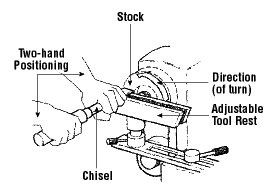Woodworking Machines - Wood Turning Lathes
On this page
What should you do before using a wood turning lathe?
Back to topA wood turning lathe can be dangerous if not used properly.
- Read the owner's manual carefully.
- Make sure you understand instructions before attempting to use any tool or machine. Only experienced and trained lathe operators should be allowed to operate lathes.
- Learn the applications and limitations before use.
- Refer to Woodworking Machines - General Safety Tips for general safety precautions.
What safety procedures should you follow when using a wood turning lathe?
Back to top- Wear safety glasses with side shields or safety goggles, or a face shield (with safety glasses or goggles) to protect yourself from flying chips.
- Wear hearing protection that is suitable for the level and frequency of the noise you are exposed to in the woodworking area.
- Wear respiratory protection when dust is generated (e.g., during sanding operations).
- Wear protective footwear when required.
- Work in well-lighted area.
- Before the lathe is turned on, make sure that all clamps and fittings are secure and that the work piece is free to turn.
- Use stock that is free of defects, such as loose knots, splits, cracks, or foreign objects.
- Hold tools firmly with both hands and against the tool rest.
- Hold the stock securely on the faceplate or between the centres.
- Use only furnished or approved tools that are meant for lathe work.
- Use sharp, well-maintained chisels and gouges.
- Select a speed that is appropriate for the job. Operate at speeds recommended by the manufacturer. Select a low speed and use a moderate cut depth to prevent splinters from flying out during roughing operations. The actual speed of the lathe depends on type of wood, a diameter of stock, nature of work being done and type of tool used.
- Adjust tool rests so that they are parallel and as close as possible to the stock. They should also be set high enough so that tools will cut into the wood slightly above the centre of the work being turned.
- Remove the tool rest when sanding or polishing.
- Use appropriate tools to hold the sand paper or emery paper whenever possible. Examples include a 'nut cracker' or the paper fixed to a piece of flat wood. If you must use your hands always hold the paper in a way that will not allow the paper to catch, pull or entangle around the stock.
- To make a faceplate turning, the one hand steadies the tip of the chisel, which holds the edge against the tool rest while the other hand guides the tool. Keep the tip of the chisel held higher than the handle.
- Turn off power and lock out the machine when making any adjustments or changes to the set up.

What should you avoid when working with a wood turning lathe?
Back to top- Do not wear gloves, loose clothing, rings or jewellery around the neck that can hang outside one's clothing. Clothing should be comfortable but not so loose that it can catch on the machine or get entangled with any rotating parts or the wood being turned; shirts should be tucked in and long hair tied back.
- Do not leave a running lathe unattended – leave only after the lathe has been turned off and it has come to a complete stop.
- Do not use makeshift tools.
- Do not use stock containing checks, splits, cracks, or knots.
- Fact sheet last revised: 2019-08-09
